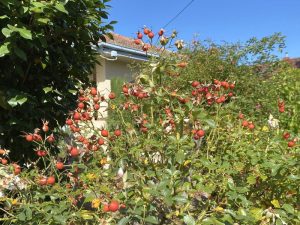Relishing the rose hip!
Robin Gale-Baker, from Sustainable Macleod, discusses rose hips. This is one of a series of articles she has written about growing fruit trees (see right hand sidebar). She has also written a number of articles about growing various vegetables, growing various herbs and general growing techniques.
 Rose hips are the fruits of roses.
Rose hips are the fruits of roses.
Rose hips are often overlooked these days which is a pity as they have significant health benefits, are tasty in a range of foods and drinks, and provide colour in the garden in autumn and winter.
Rose bushes only produce hips if their flowers are not cut off. The hip is the rounded, or oval, leathery seed pod beneath the flower petals. It develops after pollination. Cutting off roses for fresh flowers removes the hip (note, however, that, as with other flowering plants, removing dead rose flowers causes the plant to cease putting energy into producing seed and this then goes into producing more blooms).
The hip is generally red or orange when ripe in late autumn but can be yellow, purple or black. It contains both seeds and hairs, the hairs being an irritant that can cause itching and which need to be removed for culinary purposes. The hairs are in fact used to make itching powder, sold for pranks by joke shops. For harvesting, select hips in autumn that are firm and colourful and leave those that are either wrinkly or mushy for the birds.
To propagate from hips, scrape the seeds out and bury them in shallow soil. They will need a winter’s chill to germinate and, in the case of the dog rose (Rosa canina), two winters. Because of the length of time before germination, label the area carefully.
The health benefits of eating rose hips include a very high content of Vitamin C – the highest of almost any food. In his book The Complete Book of Fruit Growing in Australia, Louis Glowinski recounts that, during World War 2, the British government issued recipes for rose hip syrup and encouraged people to forage for rose hips to boost the health of the nation. There have also been some studies that indicate rose hips may reduce arthritic pain to a small extent. Finally, they are regarded as high in antioxidants, have anti-inflammatory properties and improve collagen in skin.
The culinary uses are wide: jellies, syrups, pies (often combined with other fruit such as apples or berries), puddings, jams, sauces, vinegars, fruit leathers, sugars and honey, soup and (of course) rose hip tea. Rose hip wine, brandy and mead are all made in various European countries.
Not all rose hips taste good but all are edible, and almost all roses produce hips. Some hips are sweet and tangy, others tart but edible, and some decidedly unappetising. Ideally, it is best to harvest hips after the first frost to improve their flavour but, as we rarely get early frosts, this is not usually an option here in Melbourne. The tastiest rose hips come from Rogusa roses, which are recognisable by stems with a multitude of fine prickles, very close together. Other delectable hips are those of the dog rose (Rosa canina) and the apple rose (Rosa villosa).
To prepare rose hips for culinary purposes, cut them from the bush with secateurs, trim the top and bottom with a sharp knife, then cut them in half. Scrape out the seeds and hairs, leaving a shell. Rinse thoroughly in cold water to remove any remaining hairs. They can then be used fresh, or dried for future use (using a slow oven or a dehydrator) or frozen. Do not use aluminium saucepans or utensils as these discolour the hips and destroy the Vitamin C content. You will find plenty of recipes for rose hips dishes on the Internet.
